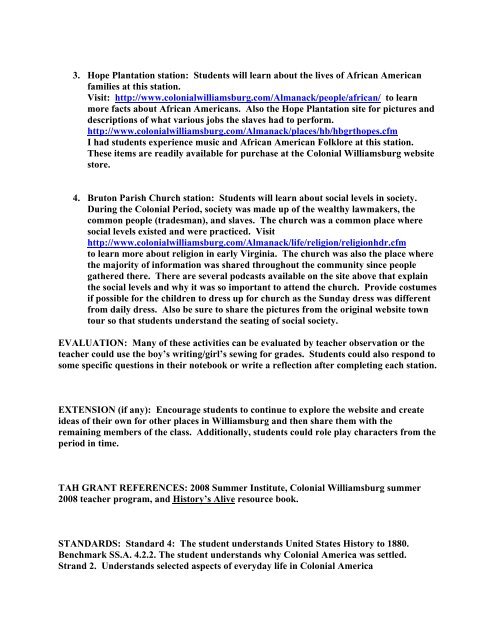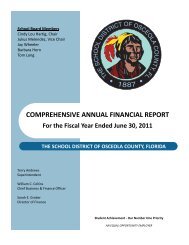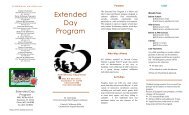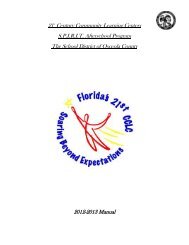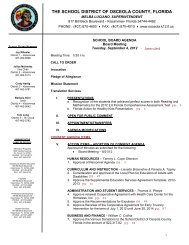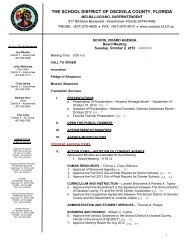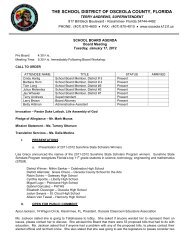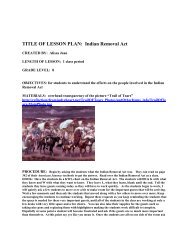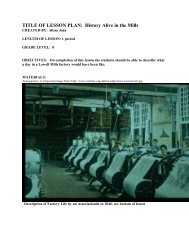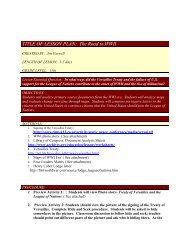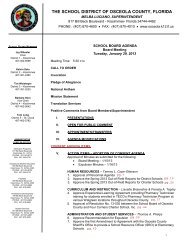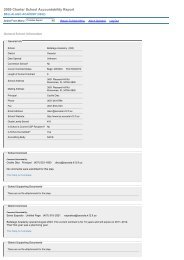TITLE OF LESSON PLAN: Colonial Williamsburg in a week (or longer)
TITLE OF LESSON PLAN: Colonial Williamsburg in a week (or longer)
TITLE OF LESSON PLAN: Colonial Williamsburg in a week (or longer)
Create successful ePaper yourself
Turn your PDF publications into a flip-book with our unique Google optimized e-Paper software.
3. Hope Plantation station: Students will learn about the lives of African American<br />
families at this station.<br />
Visit: http://www.colonialwilliamsburg.com/Almanack/people/african/ to learn<br />
m<strong>or</strong>e facts about African Americans. Also the Hope Plantation site f<strong>or</strong> pictures and<br />
descriptions of what various jobs the slaves had to perf<strong>or</strong>m.<br />
http://www.colonialwilliamsburg.com/Almanack/places/hb/hbgrthopes.cfm<br />
I had students experience music and African American Folkl<strong>or</strong>e at this station.<br />
These items are readily available f<strong>or</strong> purchase at the <strong>Colonial</strong> <strong>Williamsburg</strong> website<br />
st<strong>or</strong>e.<br />
4. Bruton Parish Church station: Students will learn about social levels <strong>in</strong> society.<br />
Dur<strong>in</strong>g the <strong>Colonial</strong> Period, society was made up of the wealthy lawmakers, the<br />
common people (tradesman), and slaves. The church was a common place where<br />
social levels existed and were practiced. Visit<br />
http://www.colonialwilliamsburg.com/Almanack/life/religion/religionhdr.cfm<br />
to learn m<strong>or</strong>e about religion <strong>in</strong> early Virg<strong>in</strong>ia. The church was also the place where<br />
the maj<strong>or</strong>ity of <strong>in</strong>f<strong>or</strong>mation was shared throughout the community s<strong>in</strong>ce people<br />
gathered there. There are several podcasts available on the site above that expla<strong>in</strong><br />
the social levels and why it was so imp<strong>or</strong>tant to attend the church. Provide costumes<br />
if possible f<strong>or</strong> the children to dress up f<strong>or</strong> church as the Sunday dress was different<br />
from daily dress. Also be sure to share the pictures from the <strong>or</strong>ig<strong>in</strong>al website town<br />
tour so that students understand the seat<strong>in</strong>g of social society.<br />
EVALUATION: Many of these activities can be evaluated by teacher observation <strong>or</strong> the<br />
teacher could use the boy’s writ<strong>in</strong>g/girl’s sew<strong>in</strong>g f<strong>or</strong> grades. Students could also respond to<br />
some specific questions <strong>in</strong> their notebook <strong>or</strong> write a reflection after complet<strong>in</strong>g each station.<br />
EXTENSION (if any): Encourage students to cont<strong>in</strong>ue to expl<strong>or</strong>e the website and create<br />
ideas of their own f<strong>or</strong> other places <strong>in</strong> <strong>Williamsburg</strong> and then share them with the<br />
rema<strong>in</strong><strong>in</strong>g members of the class. Additionally, students could role play characters from the<br />
period <strong>in</strong> time.<br />
TAH GRANT REFERENCES: 2008 Summer Institute, <strong>Colonial</strong> <strong>Williamsburg</strong> summer<br />
2008 teacher program, and Hist<strong>or</strong>y’s Alive resource book.<br />
STANDARDS: Standard 4: The student understands United States Hist<strong>or</strong>y to 1880.<br />
Benchmark SS.A. 4.2.2. The student understands why <strong>Colonial</strong> America was settled.<br />
Strand 2. Understands selected aspects of everyday life <strong>in</strong> <strong>Colonial</strong> America


